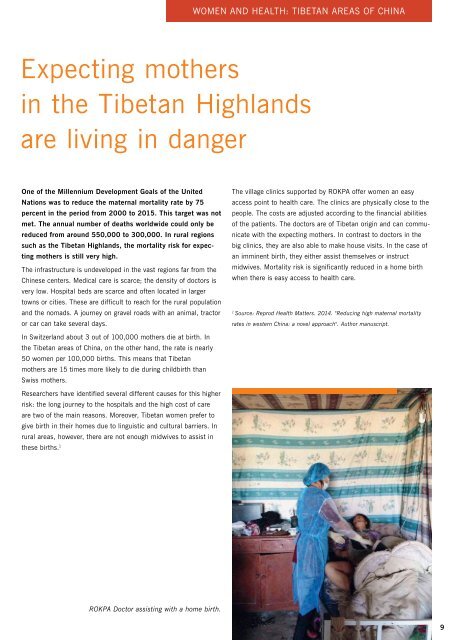ROKPA Times March 2017 - For strong girls and women
Our magazine, the "ROKPA Times", appears several times per year and reports in detail on current and planned ROKPA projects in the Tibetan areas of China, in Nepal and in Africa.
Our magazine, the "ROKPA Times", appears several times per year and reports in detail on current and planned ROKPA projects in the Tibetan areas of China, in Nepal and in Africa.
You also want an ePaper? Increase the reach of your titles
YUMPU automatically turns print PDFs into web optimized ePapers that Google loves.
WOMEN AND HEALTH: TIBETAN AREAS OF CHINA<br />
Expecting mothers<br />
in the Tibetan Highl<strong>and</strong>s<br />
are living in danger<br />
One of the Millennium Development Goals of the United<br />
Nations was to reduce the maternal mortality rate by 75<br />
percent in the period from 2000 to 2015. This target was not<br />
met. The annual number of deaths worldwide could only be<br />
reduced from around 550,000 to 300,000. In rural regions<br />
such as the Tibetan Highl<strong>and</strong>s, the mortality risk for expecting<br />
mothers is still very high.<br />
The infrastructure is undeveloped in the vast regions far from the<br />
Chinese centers. Medical care is scarce; the density of doctors is<br />
very low. Hospital beds are scarce <strong>and</strong> often located in larger<br />
towns or cities. These are difficult to reach for the rural population<br />
<strong>and</strong> the nomads. A journey on gravel roads with an animal, tractor<br />
or car can take several days.<br />
The village clinics supported by <<strong>strong</strong>>ROKPA</<strong>strong</strong>> offer <strong>women</strong> an easy<br />
access point to health care. The clinics are physically close to the<br />
people. The costs are adjusted according to the financial abilities<br />
of the patients. The doctors are of Tibetan origin <strong>and</strong> can communicate<br />
with the expecting mothers. In contrast to doctors in the<br />
big clinics, they are also able to make house visits. In the case of<br />
an imminent birth, they either assist themselves or instruct<br />
midwives. Mortality risk is significantly reduced in a home birth<br />
when there is easy access to health care.<br />
1<br />
Source: Reprod Health Matters. 2014. "Reducing high maternal mortality<br />
rates in western China: a novel approach". Author manuscript.<br />
In Switzerl<strong>and</strong> about 3 out of 100,000 mothers die at birth. In<br />
the Tibetan areas of China, on the other h<strong>and</strong>, the rate is nearly<br />
50 <strong>women</strong> per 100,000 births. This means that Tibetan<br />
mothers are 15 times more likely to die during childbirth than<br />
Swiss mothers.<br />
Researchers have identified several different causes for this higher<br />
risk: the long journey to the hospitals <strong>and</strong> the high cost of care<br />
are two of the main reasons. Moreover, Tibetan <strong>women</strong> prefer to<br />
give birth in their homes due to linguistic <strong>and</strong> cultural barriers. In<br />
rural areas, however, there are not enough midwives to assist in<br />
these births. 1<br />
<<strong>strong</strong>>ROKPA</<strong>strong</strong>> Doctor assisting with a home birth.<br />
9















